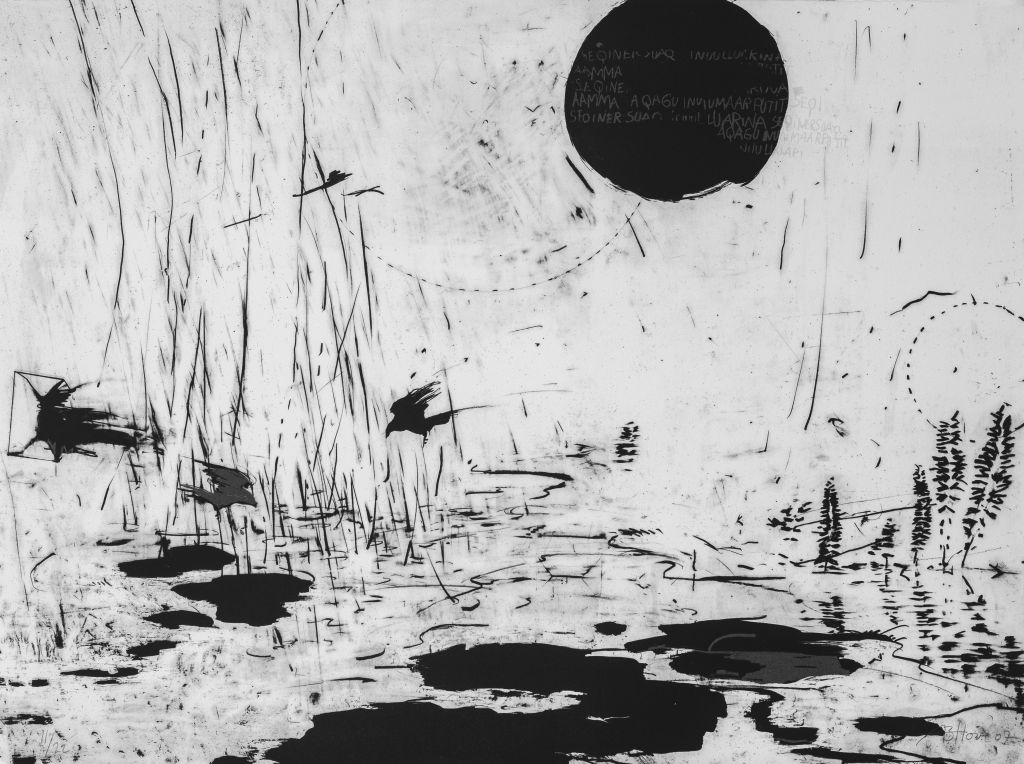
Five Letters // Anne-Birthe Hove (1951-2012)
In 2007, Anne-Birthe Hove created the series Five Letters, which consists of five lithographic prints. The prints mix landscapes from Greenland with letters in the form of envelopes, stamps and the @ sign. The prints contain innumerable small details and various reprints in an infinite limitlessness. The sharp viewer will also discover that Hove reuses motifs from the series ‘Mellemtid’ and ‘N. W. Tundra’ in several of the prints. Five Letters is printed in the Faroe Islands by SteinPrent, and was made for the expedition ship M/S Fram, where the prints were to decorate the ship’s cabins. ****
A print from the Five Letters series can be seen at Nuuk Art Museum. At first glance, the work appears as a jumble of lines on a white background. But as eyes that have to adjust to the dark after being exposed to light, the eyes also have to adjust to recognizing the neat lines showing precipitation, birds, plants and celestial bodies. Gradually, simple lines and larger black surfaces emerge into what looks more like a still image from a wet autumn day. At the bottom of the paper, dark stains form and create associations to lakes, while the left side of the paper is heavy with precipitation in the form of thin lines. A pair of ravens fly around in the pouring rain over the dark lakes. The sketchy lines of the print give a “raw” image of the Greenlandic weather, when it is extremely cold, wet and slushy. The motif of the work is without a horizon, but instead contains a hint of infinity. And that’s how it is sometimes, when the rain blocks the ability to orient oneself in the world.
Nature seems recognizable and at the same time like something from a parallel universe. In the sky, three circular objects hover, as in imaginative science fiction, where planets hover in close orbit around the earth. Are they suns? Planets? Maybe just outlines of their shadows? A black object hover around the center of the upper part of the print. Inside it there is a text, written in silver marker across the black circle, which reveals that it is probably the sun. The words are from a song or verse “Seqinersuaq inuulluarina”, which is sung to the sun when it sets for the last time before the long winter darkness.¤
Apart from the three floating planets, the motif is incredibly lifelike, and seems more thematically coherent than the other prints in the series. However, an unknown element sneaks in in the form of an envelope which splatters black ink on the left side of the work. The envelope seems out of place in nature, and at the same time connects the work to the other prints in the Five Letters series. You will find many repeats in the series, but all in new reproductions that are either enlarged, reduced or mirrored. Some of the elements that are repeated in all the prints are envelopes, the @ symbol and stamps. All the elements speak to the theme of the series’ title: Five Letters, whether the letter is handwritten and must be posted with a stamp, or typed on a keyboard to a recipient with an @.
For the last several years of Hove’s life, she worked in the series format. Characteristic of Hove’s artistic work in each series was that she delved into particular techniques and methods. Each series reflected a technical era. Some of her other series are: N. W. Tundra, 1999-2002 (photogravure and etching); Sermitsiaq, 2001-2003 (photogravure, chine collé and etching); Mellemtid (Meantime), 2003 (cold needle, chine collé and etching); Modvind (Headwind), 2004 (chine collé and etching); Tupilak, 2004 (photopolymer, printed a la poupee); Siku, 2005 (photogravure); Man kan ikke høre solnedgangen (You can’t hear the sunset), 2007 (monotype).**
Anne-Birthe Hove was educated at the Grafisk Værksted (Graphic Workshop) in Nuuk, as one of the first students when it opened in 1972. She then studied at the Design School in Kolding and at the Royal Danish Academy of Fine Arts in Copenhagen. Hove is best known for her work with graphics, but was also a painter and sculptor.* Hove worked with social realism in the 60s and 70s, with a focus on the drastic social development in Greenland. Through her art, she tackled the country’s rapid transformation into big cities and all the social problems that escalated as a result of this development. Hove’s social realism is expressed in her processing of the meeting between nature and culture. What remains is the renowned llife’s work of Anne-Birthe Hove, who as an artist left her mark in recent history and in Greenlandic art. ***
This article was written by Emma Magnussen. 2023.
References:
*Chemnitz, Jørgen. Forord, i Anne-Birthe Hove, red. Jørgen Chemnitz, 2016. Anne-Birthe Hoves arvinger & milik publishing.
**Kataloget til ”Grønlandske streger. Nyere grafik af Anne-Birthe Hove” fra Vejle Kunstmuseum. 2008.
***Therkildsen, Lene. En kunstner med noget på hjerte. Neriusaaq, nr. 2/2005.
**** Nuuk Kunstmuseum, Five Letters Klub
¤ Afsked med solen i Qaanaaq. Sermitsiaq.AG, 2009. https://sermitsiaq.ag/node/71618
